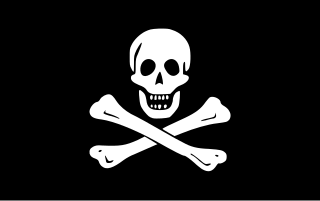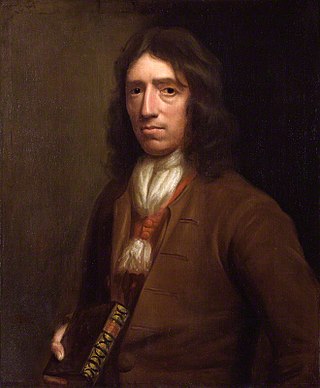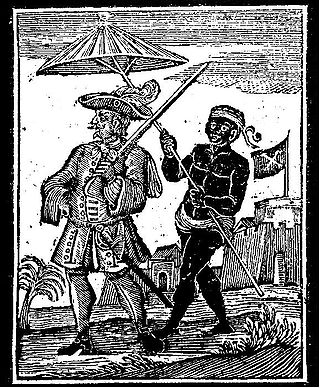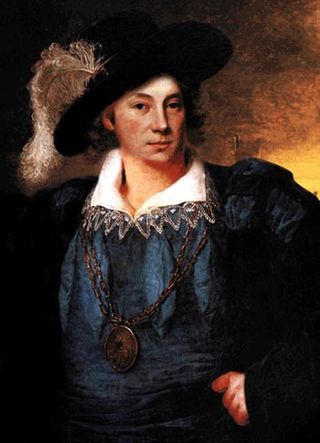Related Research Articles

Piracy is an act of robbery or criminal violence by ship or boat-borne attackers upon another ship or a coastal area, typically with the goal of stealing cargo and other valuable goods. Those who conduct acts of piracy are called pirates, vessels used for piracy are pirate ships. The earliest documented instances of piracy were in the 14th century BC, when the Sea Peoples, a group of ocean raiders, attacked the ships of the Aegean and Mediterranean civilisations. Narrow channels which funnel shipping into predictable routes have long created opportunities for piracy, as well as for privateering and commerce raiding.

Buccaneers were a kind of privateers or free sailors particular to the Caribbean Sea during the 17th and 18th centuries. First established on northern Hispaniola as early as 1625, their heyday was from the Restoration in 1660 until about 1688, during a time when governments were not strong enough and did not consistently attempt to suppress them.

William Dampier was an English explorer, pirate, privateer, navigator, and naturalist who became the first Englishman to explore parts of what is today Australia, and the first person to circumnavigate the world three times. He has also been described as Australia's first natural historian, as well as one of the most important British explorers of the period between Francis Drake and James Cook ; he "bridged those two eras" with a mix of piratical derring-do of the former and scientific inquiry of the latter. His expeditions were among the first to identify and name a number of plants, animals, foods, and cooking techniques for a European audience, being among the first English writers to use words such as avocado, barbecue, and chopsticks. In describing the preparation of avocados, he was the first European to describe the making of guacamole, named the breadfruit plant, and made frequent documentation of the taste of numerous foods foreign to the European palate such as flamingo and manatee.
This timeline of the history of piracy in the 1680s is a chronological list of key events involving pirates between 1680 and 1689.

Edward England was an Irish pirate. The ships he sailed on included the Pearl and later the Fancy, for which England exchanged the Pearl in 1720. His flag was the classic Jolly Roger — almost exactly as the one "Black Sam" Bellamy used — with a human skull above two crossed bones on a black background. Like Bellamy, England was known for his kindness and compassion as a leader, unlike many other pirates of the time.

Henry Every, also known as Henry Avery, sometimes erroneously given as Jack Avery or John Avery, was an English pirate who operated in the Atlantic and Indian oceans in the mid-1690s. He probably used several aliases throughout his career, including Benjamin Bridgeman, and was known as Long Ben to his crewmen and associates.

The Golden Age of Piracy is a common designation for the period between the 1650s and the 1730s, when maritime piracy was a significant factor in the histories of the North Atlantic and Indian Oceans.

Bartholomew Sharp was an English buccaneer and privateer. His career of piracy lasted seven years (1675–1682). In the Caribbean he took several ships, and raided the Gulf of Honduras and Portobelo. He took command of an expedition into the Pacific and spent months raiding settlements on the Pacific Coast of South America including La Serena which he torched in 1680. His flagship, taken at Panama, was the Trinity.

Laurens Cornelis Boudewijn de Graaf was a Dutch pirate, mercenary, and naval officer in the service of the French colony of Saint-Domingue during the late 17th and early 18th century.

John Halsey was a British privateer and a later pirate who was active in the Atlantic and Indian Oceans during the early 18th century. Although much of his life and career is unknown, he is recorded in A General History of the Pyrates which states "He was brave in his Person, courteous to all his Prisoners, lived beloved, and died regretted by his own People. His Grave was made in a garden of watermelons, and fenced in with Palisades to prevent his being rooted up by wild Hogs."

Edward Davis or Davies was an English buccaneer active in the Caribbean during the 1680s and would lead successful raids against Leon and Panama in 1685, the latter considered one of the last major buccaneer raids against a Spanish stronghold. Much of his career was later recorded by writer William Dampier in A New Voyage Round the World (1697).
Captain John Coxon, sometimes referred to as John Coxen, was a late-seventeenth-century buccaneer who terrorized the Spanish Main. Coxon was one of the most famous of the Brethren of the Coast, a loose consortium of pirates and privateers. Coxon lived during the Buccaneering Age of Piracy.

Bartolomeu Português (1623–1670) was a Portuguese buccaneer who attacked Spanish shipping in the late 1660s. Português was responsible for the creation of the first "Pirate's Code".

Piracy was a phenomenon that was not limited to the Caribbean region. Golden Age pirates roamed off the coast of North America, Africa and the Caribbean.

The Flying Gang was an 18th-century group of pirates who established themselves in Nassau, New Providence in the Bahamas after the destruction of Port Royal in Jamaica. The gang consisted of the most notorious and cunning pirates of the time, and they terrorized and pillaged the Caribbean until the Royal Navy and infighting brought them to justice. They achieved great fame and wealth by raiding salvagers attempting to recover gold from the sunken Spanish treasure fleet. They established their own codes and governed themselves independent from any of the colonial powers of the time. Nassau was deemed the Republic of Pirates as it attracted many former privateers looking for work to its shores. The Governor of Bermuda stated that there were over 1,000 pirates in Nassau at that time and that they outnumbered the mere hundred inhabitants in the town.
Jean Fantin was a French pirate active in the Caribbean and off the coast of Africa. He is best known for having his ship stolen by William Kidd and Robert Culliford.
Jean Charpin was a French pirate and buccaneer active in the Caribbean and off the coast of Africa. He is best known for sailing alongside Jean-Baptiste du Casse as well as for his Articles, or “Pirate Code.”
Mathurin Desmarestz was a French pirate and buccaneer active in the Caribbean, the Pacific, and the Indian Ocean.
Nicolas Brigaut (1653–1686) was a French pirate and buccaneer active in the Caribbean. He was closely associated with fellow corsair Michel de Grammont.
John Eaton was an English buccaneer and pirate active off the coasts of Spanish Central and South America. He circumnavigated the world before returning to England.
References
- 1 2 Grey, Charles (1933). Pirates of the eastern seas (1618-1723): a lurid page of history. London: S. Low, Marston & co., ltd. Retrieved 26 June 2017.
- 1 2 3 4 5 Hill, S. Charles (1919). Carnac, Sir Richard Temple (ed.). "EPISODES OF PIRACY IN THE EASTERN SEAS". Indian Antiquary a Journal of Oriental Research. Delhi: Swati Publications. 48: 217–219. Retrieved 4 October 2019.
- 1 2 3 4 Lázaro, Fabio López (2011). "The True Adventures of a Spanish American with 17th-Century Pirates". The Misfortunes of Alonso Ramírez: The True Adventures of a Spanish American with 17th-Century Pirates. Austin: University of Texas Press. pp. 57–89. doi:10.7560/726314. ISBN 9780292726314. JSTOR 10.7560/726314.
